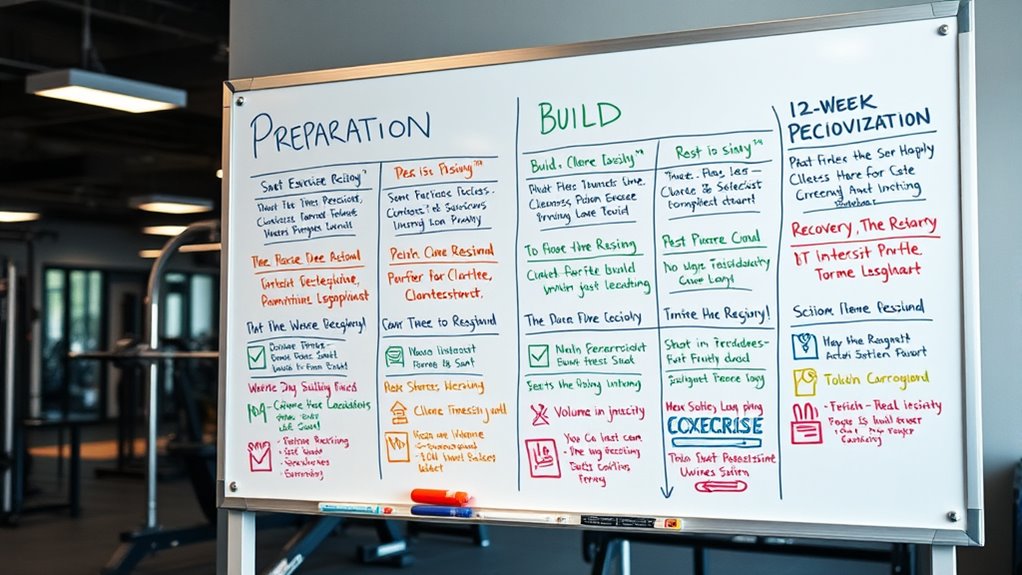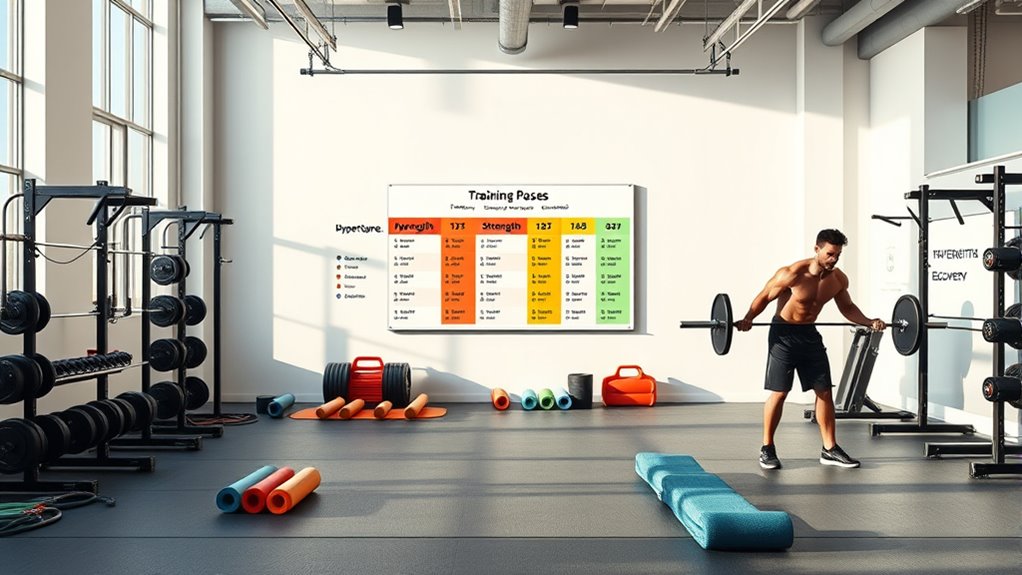In a 12-week block, periodization helps you organize your training into specific phases, like accumulation, transformation, and recovery, each with clear goals. You increase volume first, then intensity, and finally taper before competition. This controlled progression prevents overtraining, boosts performance, and keeps you motivated. If you want to optimize your plan effectively, understanding how to structure these phases and adapt as you go will give you an edge.
Key Takeaways
- Divide the 12-week plan into distinct phases: accumulation, transformation, and tapering.
- Focus on gradually increasing volume in early phases and intensity in later stages.
- Adjust training variables weekly based on performance to promote steady progress.
- Incorporate recovery periods to prevent overtraining and optimize adaptation.
- Use clear benchmarks and tools to track progress and inform training adjustments.

Have you ever wondered how athletes consistently improve over time without burning out or hitting plateaus? The secret often lies in effective periodization, especially when you’re planning a focused 12-week block. At the core of this approach are training cycles and progression planning, which help you optimize performance while minimizing overtraining. By breaking your training into distinct phases, you can systematically target specific goals, whether that’s building strength, increasing endurance, or improving technique.
Training cycles are the backbone of periodization. They divide your 12-week plan into manageable segments, each with a clear purpose. Typically, you’ll start with an accumulation phase, where you focus on volume and technique, gradually ramping up workload. Next comes a transformation phase, emphasizing intensity and specific adaptations, followed by a taper or recovery period before competition or peak performance. This structured approach prevents you from overloading your body too quickly and guarantees your progress is sustainable.
Training cycles break down your 12-week plan into targeted phases for sustainable progress.
Progression planning within these cycles is essential. It’s not just about doing more each week; it’s about increasing training stress in a controlled way. You can do this by adjusting variables like load, volume, or intensity based on your performance and recovery. For example, during the accumulation phase, you might increase repetitions or sets gradually, focusing on mastering form. As you move into the transformation phase, you’ll shift to heavier weights or higher intensity to push your strength or power limits. The key is to plan these increases thoughtfully, giving your body time to adapt without risking injury or burnout.
In a 12-week block, progression planning helps you track your progress and make necessary adjustments. You might set specific weekly goals or use performance benchmarks to gauge improvements. This allows you to identify when you’re ready to escalate the workload or when you need to back off and recover. Properly designing your training cycles and planning progression guarantees that each phase builds on the last, creating a cumulative effect that leads to steady gains. Additionally, understanding the principles of performance kits can help you optimize your training tools for better results.
Frequently Asked Questions
How Do I Adjust Periodization for Different Fitness Levels?
You should tailor your periodization by adjusting the workload management based on your fitness level. Beginners benefit from slower progressions and more recovery to maximize training adaptations without overtraining. Advanced individuals can handle increased intensity and volume, pushing their limits for continued gains. Regularly monitor your response to training, and modify your plan accordingly to guarantee ideal adaptations while avoiding burnout or injury.
Can I Incorporate Sports-Specific Training Into a 12-Week Plan?
Yes, you can incorporate sports-specific training into your 12-week plan. Focus on training specificity by tailoring exercises to mimic your sport’s movements and energy systems. This enhances athletic performance by improving skills, strength, and endurance relevant to your sport. Carefully periodize these sessions, blending them with general fitness work, so you peak at the right time. This targeted approach maximizes your progress and readiness for competition.
What Are Common Mistakes When Designing a Periodized Program?
You’ll want to avoid the epic mistakes of progression pitfalls and overtraining risks that can sabotage your gains. Common errors include neglecting proper recovery, pushing too hard too soon, or not adjusting intensity and volume based on your progress. Overlooking these factors leads to stagnation or injury, turning your hard work into a perilous journey instead of a strategic plan. Stay attentive, listen to your body, and plan smartly.
How Do I Measure Progress During Each Phase?
To measure progress during each phase, focus on performance tracking by recording your workouts, weights, and reps consistently. Keep an eye on how your strength, endurance, or technique improve over time. If you notice stagnation, consider adjusting intensity or volume to challenge yourself further. Regularly reviewing your data helps you stay on course, ensuring you’re progressing as planned and making necessary modifications to optimize results.
Is Periodization Suitable for Beginners or Only Advanced Athletes?
You can definitely start periodization as a beginner; it’s a great way to avoid burning out. Think of it as a win-win situation—adjusting training intensity and workout variety keeps things fresh and manageable. While advanced athletes fine-tune their plans, beginners benefit from structured progression, building a solid foundation. So, don’t wait until you’re an expert—periodization helps you stay motivated and see steady progress from the get-go.
Conclusion
By understanding periodization, you can strategically plan your 12-week training to peak at the right time. For instance, imagine you’re preparing for a marathon—gradually increasing your mileage during the initial months, then focusing on speed work before tapering. This structured approach helps prevent burnout and injuries while maximizing gains. Keep adjusting your plan based on progress, and you’ll stay on track to reach your goals effectively and efficiently.









